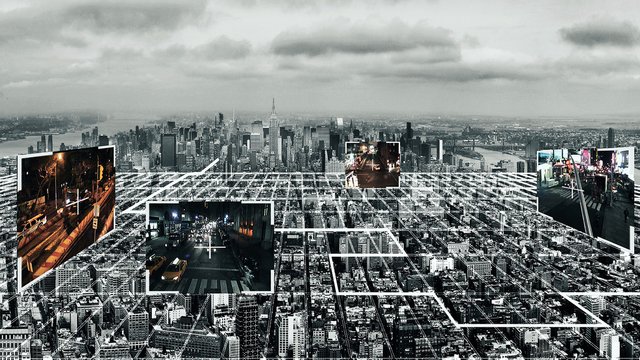Smart Cities as an Urban-Panopticon and Informational Space
The disciplinary concept of the panopticon Jeremy Bentham envisioned in the 18th century is primarily an architectural design and a technology of power to solve the problems of surveillance. In his vision, a central observation tower is surrounded by a circular building, divided into individual cells, all illuminated by sunlight shining through a window in the cell. This architectural design gives the guards in the tower the possibility to observe the incarcerated individuals while – due to mechanisms mounted on the observation tower – not being seen themselves. Thus, the surveillance ability is fully deployed as the actors are subject to the possibility of constant scrutiny without being able to verify the power applied to them. This permanent visibility, even if its action is discontinuous, assures the functioning and maintenance of the power involved, which is internalized by the inmates and simultaneously leads to a permanent principle of self-subjection (Gray, 2003: 320; Foucault, 1980: 148; Foucault, 1995: 200-3; Koskela, 2003: 293).

The concept of video surveillance in cities is similar. It is “a technological solution designed to solve the problems of surveillance in urban space” (Koskela, 2003: 293). Therefore, space and the conceptualization thereof are crucial in understanding today’s social power relations. Contextual surveillance with unverifiability, yet invisibility, leads to an internalization of control or permanent self- subjection in smart cities. This unidentifiable or unverifiable authoritarian scrutiny can be a threat to subjects rather than providing them with security (Koskela, 2003: 299).
Visibility is the exertion of power through a disciplinary gaze and, moreover, the basic condition to collect information and knowledge about individuals. Also to deter deviant behavior and keep social space safe and ordered while willingly taking the risk of exclusion. The visibility through surveillance cameras, if recognized by the individual, is not mutual because it is impossible to actively respond to the scrutiny. One can only be the observed but not the observer (Koskela, 2003: 298) as it is transparent from one side and opaque from the other.
This draws upon mythology and religious roots as the ubiquitous gaze has god-like features: present and not present at the same time, unverifiable and concurrently verifiable in its institutionalization. Spinoza (2003) considered God with an accurate metaphor, even though not in the light of surveillance: “He, who loves God, cannot endeavour that God should love him in return” (PROP. XIX). This love is in proportion to the others having the same bond based on the attributes ascribed to God, “which express eternal and infinite essence [...] and which without God cannot exist or be conceived” (Spinoza, 2003: PROP. XXIX). In terms of surveillance, all the attributes ascribed to observation alongside the myriad agencies and potential drawbacks the same way political and economic factors would not exist without the development and implementation of technologies, systems, and mechanisms. Such mechanisms have been created artificially based on interests related to power and are not exercised entirely over the others since “[i]t’s a machine in which everyone is caught, those who exercise power just as much as those over whom it is exercised” (Foucault, 1980: 156).
With regard to data and information, the instinctive use of power through surveillance links space and knowledge with categorization and disciplining its inhabitants for no particular reason. Among the critiques of increasing surveillance is the presumption that it changes social space and practices. It may lead to segregation, polarization or less spontaneous and less lively urban areas by reinforcing the homogenization of inhabitants. The latter is particularly crucial since heterogeneity is what constructs the cultural life in a modern city. Camera surveillance is hereby an approach that uses technology to make it subtle while intense at the same time as it “spreads from material space to cyberspace” (Koskela, 2003: 294). The Internet distributes local images and connects them with a global community in a transformation from local presence to tele-presence as the main component of representation (Virilio, 2002: 109-10).

For Foucault (1980; 1995; 1997), a space’s meaning derives from a trialectic contextualization of social relations, spatial forms and the exertion of power and knowledge in terms of information and technology. Smart cities are characterized by synchronically linking material and ideological domains. However, Koskela (2003: 296) argues that Foucault’s focus is more on power and knowledge rather than the spaces themselves. This seems rather surprising as his analysis focuses on clearly defined and systematically implemented and segregated institutional spaces such as prisons, schools or hospitals. When it comes to surveillance in urban areas, the concepts of contextual construction and implementation are important factors as
power and space are situated in a complex reciprocal relation. Foucault (1997) further mentions the decreasing importance of time as he considers our era “to be that of space. We are in the age of the simultaneous, of juxtaposition, the near and the far, the side by side and the scattered” (330). Space is a representation of human behavior, cultures, politics, and economy linked to time through an ephemeral equilibrium.
According to Manuel Castells (2005: 4-10) the information society transforms the perception of the time and space equilibrium through the ‘space of flows’. As space organizes time through the global flow of information, making time more flexible, the relationship between society and architecture also transforms. The structural logic of the space of flows is spaceless and increasingly timeless. Hence, surveillance transcends temporal and spatial barriers, as highly secured control rooms can be located anywhere under the premise that they are included in the network. ICTs intensified a temporal and spatial double life since recorded footage or gathered information is transported in real-time between nodes of the surveillance networks. “We are at one and the same time here and somewhere else” (Beck, 1992: 133) but such technologies also isolate and initiate a uniformity of life.
Jeremy Bentham’s panopticon is metaphorically used throughout this work because it does not identically fit the dispersed and flexible characteristics of modern surveillance. Yet, some characteristics regarding the panopticization of urban space are similar, making it a compatible example to better understand surveillance in cities (Koskela, 2003: 293). One characteristic of smart cities is that informational nodes efficiently process data, private information or content to contribute to the network’s goal. According to Castells (2005: 3), nodes in this sense function and exist as components of networks and contribute to the organizational capacity and ability. Thus, smart cities are artificial components of networks exchanging knowledge within the space of flows. This enables the synchronous integration of technological, informational or social relations regardless of contexts and without contiguity for all nodes included in this space (Castells, 2005: 11). Such networks are characterized by a binary logic of exclusion or inclusion. The distance of nodes excluded from the particular network tends to infinity, whereas the distance between nodes included in it tends to zero (Castells, 2005: 4). When applied to surveillance technology and its networks, being excluded based on the presumption of innocence is advantageous. Habermas (1991) also embarked upon the exclusion of networks when he elaborated on the public sphere and its constraining and enabling aspects. The modern public sphere creates its own limits and inherent critiques by excluding individuals with fewer material resources or formal education from the political debate. In terms of social control through surveillance, the oligopoly of politically and economically effective and influential assemblies threatens the public consensus (Habermas, 1991: 228).
Emerging surveillance technologies may lead to jeopardized privacy and security solutions and could eventually lead to greater threats than they initially anticipated. Privacy is crucial in the development of human beings as individuality stems from the choices made in private settings to form an identity. Collecting data about individuals through surveillance, regardless of underlying agencies, surfaces further threats for urbanites. A comprehensive profile of a person can be compiled when independently gathered information is assembled and based on the emergence principle. This resembles Aristotle’s famous quote “the whole is greater than the sum of its parts”. The result of the synergy of parts a system contains, shows that its constitutive characteristics are not solely explainable through the characteristics of the isolated parts. Therefore, the compound, when compared to its elements, appears as something emergent and new. This emergent direction is embedded in uncertainty and may result in unanticipated consequences. Thus making it a political necessity to draw the line on a spectrum of public safety and privacy as knowledge about individuals can result in another form of control. Besides the decisive collection of information, the usage of information for risk management and data analysis (Gray, 2003: 317-9) can be driven by multiple underlying agencies like economical interests or security concerns. However, there is no redemption of recorded content and the lack of situational context in the gathered information can have crucial repercussions. In a similar vein, Fuchs (2013: 35) focuses on the capitalistic exploitation of big data derived from social media. User-generated content is collected, processed and scrutinized by capitalist interests and corporate advertising. This serves as an example for data collection without consent, which – according to Fuchs’ theory - surveillance can be classified as.
References
Beck, U. (1992). Risk Society – Towards a new Modernity. London: Sage Publications
Castells, M. (2005). The Network Society: A Cross-Cultural Perspective. UK: Edward Elgar Publishing
Foucault, M. (1980). The eye of power. In Gordon, C. (Ed.), Power/Knowledge: Selected Interviews and Other Writings 1972-1977 by Michel Foucault, 146- 165. New York: Pantheon Books
Foucault, M. (1995). Discipline and Punish: The Birth of the Prison (2nd ed.) (A. Sheridan Trans.). New York: Vintage Books. Retrieved 12.4.2017, from monoskop.org/images/4/43/Foucault_Michel_Discipline_and_Punish_ The_Birth_of_the_Prison_1977_1995.pdf
Foucault, M. (1997). Of other spaces: Utopias and Heterotopias. In Leach, N. (Ed.), Rethinking Architecture: A Reader in Cultural Theory, 330-336. NYC: Routledge. Retrieved 11.04.2017, from designpracticesandparadigms.files.wordpress.com/2013/01/leach-ed- rethinking-architecture.pdf
Fuchs, C. (2013). Social Media and Capitalism. In Tobias Olsson (Ed.), Producing the Internet. Critical Perspectives of Social Media, 25-44. Göteborg: Nordicom
Gray, M. (2003). Urban Surveillance and Panopticism: will we recognize the facial recognition society? Surveillance & Society, 1(3), 314-330
Habermas, J. (1991). The Structural Transformation of the Public Sphere. Cambridge, MA: MIT Press
Koskela, H. (2003). ‘Cam Era’ – the contemporary urban Panopticon. Surveillance & Society, 1(3), 292-313
Spinoza, B. (2003). The Ethics (Trans. R. H. M. Elwes). Retrieved 31.03.2017, from gutenberg.org/files/3800/3800-h/3800-h.htm
Virilio, P. (2002). The visual crash. In T.Y. Levin, U. Frohne and P. Weibel (Eds.), CTRL [SPACE]: Rhetorics of Surveillance from Bentham to Big Brother, 108- 113. Karlsruhe: ZKM Centre for Art and Media